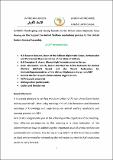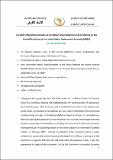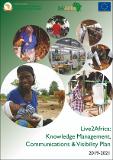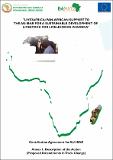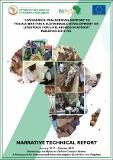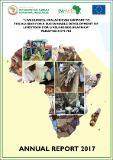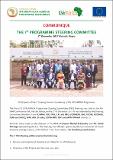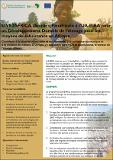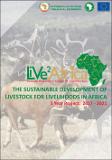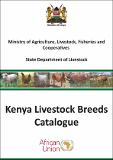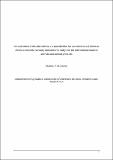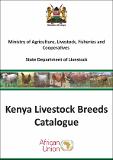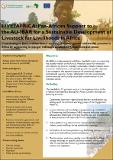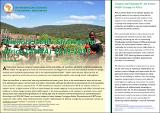AU-IBAR Initiatives and Project Reports: Recent submissions
Now showing items 81-100 of 320
-
AU-IBAR’s Thanks-giving and Closing Remarks to the African Union Diplomatic Corps Meeting on the Support to Animal Welfare resolutions process to the United Nation General Assembly
(2021-10-23)AU-IBAR’s Thanks-giving and Closing Remarks to the African Union Diplomatic Corps Meeting held on the Support to Animal Welfare resolutions process to the United Nation General Assembly. -
AU-IBAR’s Welcoming Remarks at the African Union Diplomatic Corps Meeting on the Animal Resolution at the United Nation Environment Assembly (UNEA)
(2021-11-23)AU-IBAR’s Welcoming Remarks at the African Union Diplomatic Corps Meeting on the Animal Resolution at the United Nation Environment Assembly (UNEA) held on 23rd October, 2021. -
Live2Africa: Knowledge Management, Communications & Visibility Plan 2019-2021
(2019)The strategy provides the conceptual framework and knowledge management and communication plan for the Live2Africa Project for the period 2019-2021, and the extension period up to 2022. -
Live2Africa: Contribution Agreement for AU-IBAR
(2017)The contribution agreement highlights the role of AU-IBAR in the implementation of the Pan-African Support to the AU-IBAR for a Sustainable Development of Livestock for Livelihoods in Africa – 2017-2021 -
Live2Africa narrative technical report: January 2017 – October 2018
(2018)This report covers the Live2Africa Project's implementation from its inception in January 2017 to October 2018. -
Live2Africa Annual Report- 2017
(2017)This report covers 2017 activities of the Live2Africa Project. During the period under review, the activities centered on the establishment of the project team, support strategies development at national and regional levels, ... -
Communique: 1st Steering Committee meeting of the Live2Africa Programme
(2017)This communique provides an overview of the 1st Steering Committee meeting of the Live2Africa Programme. The meeting was held at the AUIBAR Conference Hall, Nairobi, Kenya, on the 7th of December 2017. It was attended by ... -
Report of Experts’ Meeting on the Establishment and Operationalization of the Association of African Veterinary Statutory Bodies
(2018)This report is the result of a joint continental meeting for veterinary education establishments and veterinary statutory bodies organized by AU-IBAR in collaboration with Ecole Inter-Etats des Sciences et Medicine ... -
Live2Africa : Soutien Panafricain à l'UA-BIRA pour un Développement Durable de l'élevage pour les moyens de subsistance en Afrique
UA-BIRA met en oeuvre Live2Africa. Live2Africa vise à soutenir la transformation du secteur de l’élevage africain afin de contribuer davantage à un développement durable sur le plan environnemental, résilient face au ... -
Live2Africa Project Information pack
This information pack articulates Live2Africa's goals in its pursuit of sustainable and inclusive growth, as envisioned in the Livestock Development Strategy for Africa (LiDeSA). -
Kenya Livestock Breeds Catalogue
This catalogue provides consolidated information on livestock diversity available in Kenya, including their distribution, utilization, current status and associated risks. -
Ministry of Agriculture, Livestock, Fisheries and Cooperatives State Department of Livestock - Kenya Livestock Breeds Catalogue
(2019-06-01)This catalogue provides consolidated information on livestock diversity available in Kenya, including their distribution, utilization, current status and associated risks. -
Plan to Identify Investment Options in Livestock Value Chain Launched
(2021-06-09)A newspaper article on the development of the Kenya Livestock Master Plan process. AU-IBAR is supporting this initiative through the Live2Africa Project, funded by the European Union. -
Live2Africa Fact Sheet
(2020)This fact sheet highlights summary information on the Pan-African Support to the AU-IBAR for a Sustainable Development of Livestock for Livelihoods in Africa (Live2Africa) -
Animal Health Strategy for Africa - 2018-2035: Brief
(2020)This brief provides an overview of the Animal Health Strategy for Africa -
AU-IBAR Animal Health Newsletter: Issue 2, 2020
(2020-12)The second issue of the 2020 Animal Health Newsletter provides an overview of activities undertaken on animal health under the Live2Africa Project. The highlighted articles include some activities implemented , such as the ... -
Development of Livestock for Livelihoods Project to ease demand for animal products
(4/28/2021)Promotional article on Live2Africa intervention areas. Article appeared in Standard Newspaper/ Farm Africa. -
New Animal Health Strategy to propel Africa’s World Animal Resource Economy
(4/26/2021)Promotional article on the Animal Health Strategy that appeared in the Farm Kenya (Standard Media Group) Newspaper. -
African Youth in Livestock, Fisheries and Aquaculture Incubators Network (AYLFAIN) Newsletter: Issue 2
(2020)The second 2020 African Youth in Livestock, Fisheries and Aquaculture Incubators Network (AYLFAIN) Newsletter includes an in-depth interview with Divine Ntiokam, founder of the Climate Smart Agriculture Youth Network ...
